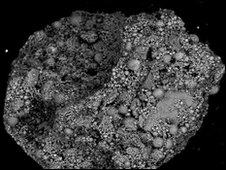S
silylene
Guest
Interesting:
http://news.bbc.co.uk/2/hi/science/nature/8547534.stm
Clues to Antarctica space blast
By Paul Rincon
Science reporter, BBC News, The Woodlands, Texas

The team's findings could help in the search for other ancient "airbursts".
A large space rock may have exploded over Antarctica thousands of years ago, showering a large area with debris, according to new research.
The evidence comes from accumulations of tiny meteoritic particles and a layer of extraterrestrial dust found in Antarctic ice cores.
Details of the work were presented at a major science conference in Texas.
The event would have been similar to the Tunguska event, which flattened a large area of Siberian forest in 1908.
It is thought to have been a so-called "airburst" in which a space rock does not reach the ground, but rather explodes in the atmosphere.
The research is based on a study of extraterrestrial debris found in granite from Miller Butte, in the Transantarctic Mountains, and a layer of cosmic dust represented in two Antarctic ice cores.
The debris from the mountains includes micrometeorites and tiny particles called spherules. The study's authors think these spherules could be material eroded from a stony meteorite as it was heated up on its way through our atmosphere.
The spherules could potentially provide a signature to look for evidence of "airbursts" in the geological record.
Wide area
The results were the subject of a presentation at the Lunar and Planetary Science Conference (LPSC) in The Woodlands, Texas.
What makes Luigi and Matthias' work so exciting is that it may give us a way of spotting these events in the geological record .
A layer of extraterrestrial dust has been found in both the Dome C and Dome Fuji ice cores from Antarctica. The dust in both cores is dated to about 481,000 years ago - and is therefore likely to derive from the same event.
The team, led by Luigi Folco and Matthias van Ginneken at the University of Siena, Italy, and including Phil Bland from Imperial College London, UK, now conclude that the Dome C and Dome Fuji dust layers are also paired with debris from the Transantarctic Mountains.
They point to strong similarities in the texture and composition of the debris found in the ice cores and that found in the granite.
However, the sites are more than 2,900km apart. For cosmic debris to be spread over such a wide area, the researchers propose that an airburst is the most likely explanation.
They estimate that it could have been caused by an object weighing 100,000 tonnes.
"We've got similar material spread over a very large area. It's difficult to do that with any other mechanism," said co-author Dr Bland.
click link for rest of story
http://news.bbc.co.uk/2/hi/science/nature/8547534.stm
Clues to Antarctica space blast
By Paul Rincon
Science reporter, BBC News, The Woodlands, Texas

The team's findings could help in the search for other ancient "airbursts".
A large space rock may have exploded over Antarctica thousands of years ago, showering a large area with debris, according to new research.
The evidence comes from accumulations of tiny meteoritic particles and a layer of extraterrestrial dust found in Antarctic ice cores.
Details of the work were presented at a major science conference in Texas.
The event would have been similar to the Tunguska event, which flattened a large area of Siberian forest in 1908.
It is thought to have been a so-called "airburst" in which a space rock does not reach the ground, but rather explodes in the atmosphere.
The research is based on a study of extraterrestrial debris found in granite from Miller Butte, in the Transantarctic Mountains, and a layer of cosmic dust represented in two Antarctic ice cores.
The debris from the mountains includes micrometeorites and tiny particles called spherules. The study's authors think these spherules could be material eroded from a stony meteorite as it was heated up on its way through our atmosphere.
The spherules could potentially provide a signature to look for evidence of "airbursts" in the geological record.
Wide area
The results were the subject of a presentation at the Lunar and Planetary Science Conference (LPSC) in The Woodlands, Texas.
What makes Luigi and Matthias' work so exciting is that it may give us a way of spotting these events in the geological record .
A layer of extraterrestrial dust has been found in both the Dome C and Dome Fuji ice cores from Antarctica. The dust in both cores is dated to about 481,000 years ago - and is therefore likely to derive from the same event.
The team, led by Luigi Folco and Matthias van Ginneken at the University of Siena, Italy, and including Phil Bland from Imperial College London, UK, now conclude that the Dome C and Dome Fuji dust layers are also paired with debris from the Transantarctic Mountains.
They point to strong similarities in the texture and composition of the debris found in the ice cores and that found in the granite.
However, the sites are more than 2,900km apart. For cosmic debris to be spread over such a wide area, the researchers propose that an airburst is the most likely explanation.
They estimate that it could have been caused by an object weighing 100,000 tonnes.
"We've got similar material spread over a very large area. It's difficult to do that with any other mechanism," said co-author Dr Bland.
click link for rest of story


